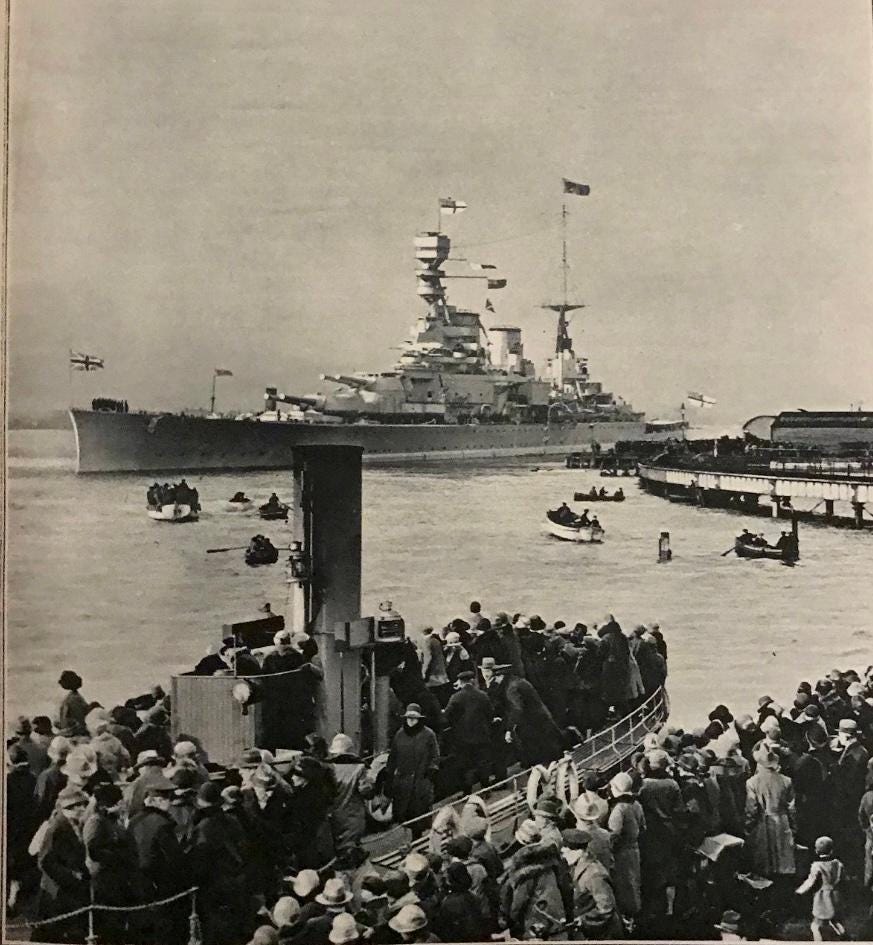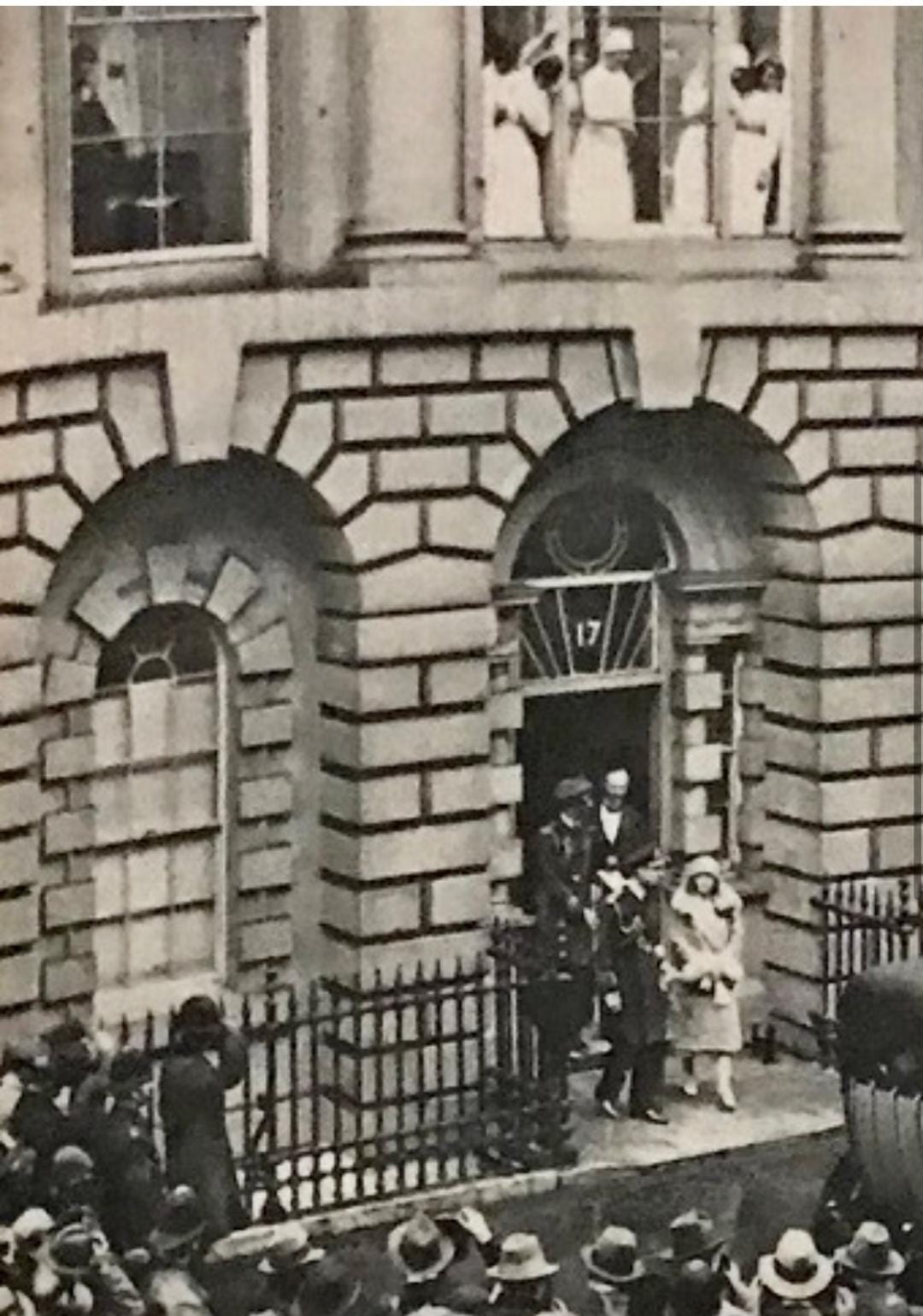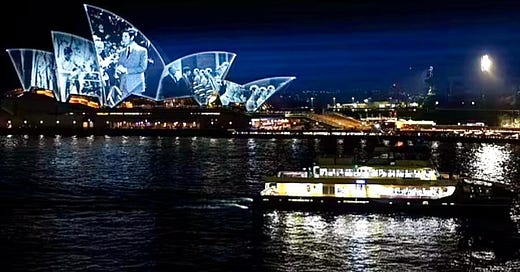Over the Top in Down Under
Charles and Camilla's visit to Australia recalls his grandfather and grandmother's landmark tour in 1927
On Friday October 18, the people of Sydney marked the first visit to Australia of a reigning King and his Queen Consort by illuminating the dramatic white sails of the city’s iconic Opera House with a montage of twenty-one images from royal tours across the decades. Seventy years earlier, his mother, Queen Elizabeth II, had made history as the first reigning monarch of Australia to visit her most distant Dominion.

Starting in 1867 when Queen Victoria’s second son, Prince Alfred, Duke of Edinburgh, traveled to Down Under, there have been more than fifty visits by members of the British royal family. The visitors have included six future kings: George V, Edward VIII, and George VI in the 20th century, and Charles III, his son Prince William and grandson Prince George in the 20th and 21st centuries. Both George V and George VI traveled to Australia as Dukes of York, in 1901 and 1927. Prince Edward toured Australia as the Prince of Wales in 1920. Before his current tour, Charles had been to Australia sixteen times, starting with his two terms at the Timbertop outpost of the Geelong Grammar School in 1966. Prince William has visited three times as an adult and once as a toddler in 1983, accompanying his mother and father, Charles and Diana, as did Prince George in 2014 with his parents, William and Catherine.

Within that extraordinary sweep of over a century and a half, the longest and most ambitious antipodean journey took place in 1927 when King Charles’s grandparents, the future King George VI and Queen Elizabeth, spent a month in New Zealand followed by two months in Australia They traveled on the battle cruiser H.M.S. Renown and were at sea for nearly three months. Elizabeth, the Duchess of York was just twenty-six-years old, and Prince Albert—known as Bertie—was thirty-one. Their biggest sacrifice in making such a grueling trip was leaving behind their eight-month-old daughter, Princess Elizabeth, the future Queen. They would not see her again until she was fourteen months old.
The circumstances of grandfather and grandson could not be more different. King Charles is seventy-five and Queen Camilla seventy-seven. He has been receiving treatment for an undisclosed form of cancer since February—a regimen that his physicians have “paused” for his eleven days abroad. He and the Queen are spending six days in Australia focusing on Sydney and Canberra—including an address to the Australian Parliament. They then travel to Samoa for the biennial meeting of government leaders who are members of the Commonwealth—a voluntary association of fifty-six nations formerly constituting the British Empire. Since its formation in 1949, the Commonwealth has had the British monarch as its ceremonial head.
Massive adulation for Bertie and Elizabeth, who weren’t even King and Queen
The biggest difference is that in 1927 the British Empire was at the height of its power, ruling the waves and controlling nearly a quarter of the world’s population. Australia was a new nation with George V as its king. The country was an integral member of the Empire and intensely devoted to Britain and the monarchy. It is amazing nearly a century later to contemplate the massive adulation for Bertie and Elizabeth, who weren’t even King and Queen.
The reception for Charles and Camilla reflects respect and admiration but it can’t come close to the experience of his grandparents. Britain today is a middle-range power that punches above its weight. Australia is a major force in its own right, with less support for the monarch as head of state. Still, the emotional ties to Britain remain strikingly strong, and by some measures growing stronger. In a 1999 referendum, 39 per cent of Australians favored becoming a republic, replacing the monarch with an elected president as head of state. Recent polls show that only 33 per cent believe the country should become a republic.

Bertie and Elizabeth had no idea that they would be a future monarch and consort. His glamorous older brother, Prince Edward, was destined by birth for the Crown. But with their marriage in April 1923, they became the popular Duke and Duchess of York, and the arrival of their “heiress presumptive” three years later raised their public profile even more.
Their mission in 1927 was to represent King George V, to deepen the nation’s loyalty to Britain and its Empire, and to recognize the progress and prosperity Australians had achieved in the three generations since the country’s founding. The duke’s most important task was to make a speech officially opening the Federal Parliament in the new capital of Canberra, still a small town of only six thousand inhabitants. Today Canberra has a population of nearly 478,000.
Bertie muscled through his anxieties
For Bertie, the biggest challenge was to give multiple speeches and to minimize the stutter that had plagued him since childhood. The Oscar-winning movie, The King’s Speech starring Colin Firth as King George VI, accurately depicted the demanding treatment routines instilled in Bertie by his Australian speech therapist, Lionel Logue. The emphasis of the film was the King’s preparation for his Coronation in 1937, and for his radio address at the start of the Second World War in 1939. Glossed over was the significant prelude in 1927, when Bertie muscled through his anxieties and performed at the podium better than expected. He practiced Logue’s breathing exercises and other techniques every day, with Elizabeth’s help.
Aside from the usual ceremonies, “loyal addresses,” and unveilings, the 1927 tour offers surprising glimpses of Bertie and Elizabeth’s experiences and attitudes that would fit with the approaches of the monarchy in 2024. The Duke and Duchess were happily engulfed by enthusiastic crowds. Elizabeth and Bertie each broke protocol to change their rigid schedules for the sake of ordinary Australians.

“Very miserable at leaving the baby,” Elizabeth wrote in her diary on January 6, 1927, as she and Bertie departed from her parents’ home at 17 Bruton Street in London. “I drank some champagne & tried not to weep.”
Keep reading with a 7-day free trial
Subscribe to ROYALS EXTRA BY SALLY BEDELL SMITH to keep reading this post and get 7 days of free access to the full post archives.



